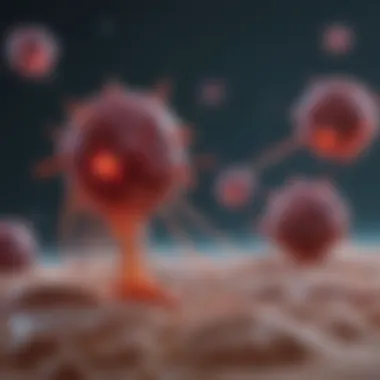Understanding Neutrophils: Key to Immune Defense


Intro
Neutrophils are essential cells in the innate immune system, integral to the body’s defense against infections and inflammation. As the most abundant type of white blood cells, they serve as the first responders to sites of injury or microbial invasion. Understanding their complex roles and mechanisms is crucial for comprehending how the immune system functions and for addressing various health disorders linked to their dysfunction. This article will provide a detailed examination of neutrophils, covering key aspects such as their development, activation processes, interactions with other immune cells, and their involvement in autoimmune diseases.
Methodology
This section outlines the research methods utilized to gather substantial insights into neutrophils and their functionalities.
Overview of research methods used
Research on neutrophils typically employs a combination of cellular biology techniques, immunology assays, and clinical studies. Isolating neutrophils from blood samples allows scientists to analyze their behavior in vitro. Additionally, animal models provide a context for studying neutrophil responses in living organisms. Recent advancements in imaging technologies have enhanced our understanding of neutrophil dynamics within tissues, revealing their behaviors in real-time.
Data collection techniques
Data collection concerning neutrophils involves several approaches:
- Flow cytometry: This technique allows for the quantification and analysis of neutrophil populations based on their surface markers.
- Microscopy: Various microscopy methods, including confocal and electron microscopy, are deployed to visualize neutrophil morphology and interactions with pathogens.
- Genomic and proteomic analyses: Techniques such as RNA sequencing provide insights into the gene expression profiles of neutrophils under different conditions, further elucidating their roles in immune responses.
- Clinical trials: Research studies involving patients with diseases linked to neutrophil dysfunction help establish correlational data between neutrophil behavior and disease outcomes.
Understanding the robustness of these methods is essential, as they underpin the evidence supporting the role of neutrophils in immune defense.
Future Directions
Despite the considerable advancements, research on neutrophils presents several areas for further inquiry.
Upcoming trends in research
Emerging trends include the exploration of neutrophil heterogeneity, understanding how different subsets of neutrophils influence immunity and pathology. Additionally, investigating the role of neutrophils in the context of microbiome interactions is gaining prominence.
Areas requiring further investigation
It is critical to better understand the mechanisms underlying neutrophil dysfunctions, especially in diseases like chronic obstructive pulmonary disease (COPD) and sepsis. Research in this domain could potentially lead to new therapeutic strategies.
Overall, neutrophils remain a significant focus in immunological research. Their versatility and importance in various biological contexts demand comprehensive studies that ongoing research must fulfill.
Preface to Neutrophils
Neutrophils are integral components of the immune system, serving as the first line of defense against infections. They are critical in combating pathogens and play a role in inflammatory responses. Understanding neutrophils is essential for various fields, including immunology, medicine, and research. This section will highlight the role of neutrophils within the immune system, their basic characteristics, and the historical background that has shaped our current understanding of these cells.
Definition and Basic Characteristics
Neutrophils are a type of white blood cell, specifically classified as granulocytes. They are characterized by a multi-lobed nucleus and their cytoplasm contains granules filled with enzymes and antimicrobial substances. These cells are produced in the bone marrow and are the most abundant type of leukocyte in humans, making up about 55% to 70% of the total white blood cell count.
Neutrophils have a lifespan of a few hours to several days, depending on their activation status and the presence of pathogens. They are known for their ability to rapidly migrate to sites of infection or tissue damage. Upon arrival, they perform crucial functions such as phagocytosis, the release of reactive oxygen species, and the formation of neutrophil extracellular traps (NETs) to ensnare pathogens.
Some key characteristics include:
- Morphology: Neutrophils appear as round cells with a segmented nucleus. The presence of granules distinguishes them from other white blood cells.
- Production: They originate from hematopoietic stem cells in the bone marrow and mature through various stages before entering the bloodstream.
- Function: Their primary role is to respond quickly to infections. They are adept at engulfing bacteria and fungi, as well as releasing chemicals to recruit other immune cells.
Historical Context
The study of neutrophils has a rich history that spans over a century. In the late 19th and early 20th centuries, advancements in microscopy allowed scientists to visualize cells and understand their functions more clearly. Elie Metchnikoff, a Russian zoologist, is often credited with the discovery of phagocytosis, a process in which neutrophils and other immune cells engulf and destroy pathogens.
Moreover, the categorization of white blood cells into different types, including neutrophils, was established in the 1900s, leading to a more detailed understanding of their roles in immune responses. Throughout the 20th century, various research efforts focused on the physiological and pathological roles of neutrophils, particularly their involvement in inflammation and infection.


Recent developments in technology have further expanded our understanding, revealing complex behaviors and signaling pathways associated with neutrophils. Research continues to elucidate their roles, linking neutrophil dysfunction to various diseases.
These insights emphasize the importance of neutrophils not only in innate immunity but also in the context of broader immunological studies. Thus, understanding the historical perspective enhances appreciation for their complexity in modern medical science.
Development and Lifespan of Neutrophils
The development and lifespan of neutrophils are crucial topics within the study of the immune system. Neutrophils, as the most abundant white blood cells, are essential for the body's first line of defense against infections. Understanding their life cycle can illuminate how these cells respond to pathogens and contribute to inflammation. Moreover, it has implications for medical conditions where neutrophil function is altered.
Hematopoiesis and Neutrophil Formation
Hematopoiesis is the process by which blood cells are formed. It primarily occurs in the bone marrow. Neutrophils originate from hematopoietic stem cells. These stem cells undergo a series of differentiation stages, ultimately leading to the production of neutrophil progenitors. The microenvironment in the bone marrow plays a significant role in guiding these progenitors to mature into functional neutrophils.
A variety of growth factors influence this process. Granulocyte-colony stimulating factor (G-CSF) is particularly important. It stimulates the production and release of neutrophils from the bone marrow into the bloodstream. This regulation is vital for the body to have a ready supply of neutrophils in response to infection.
Lifecycle and Turnover Rate
Neutrophils have a relatively short lifespan in the bloodstream, typically lasting around 5 to 90 hours. This turnover rate is much faster than that of other immune cells like lymphocytes. After entering circulation, neutrophils patrol for threats. They quickly migrate to sites of infection or inflammation, where they perform their functions.
Once they complete their duty, typically characterized by phagocytosis or the release of antimicrobial substances, neutrophils undergo apoptosis. This programmed cell death helps maintain homeostasis and prevents excessive inflammation. Additionally, the rate at which neutrophils are produced must match the demand during infections. A disequilibrium can lead to neutropenia or excessive neutrophilia, both of which can cause health issues.
Maturation Process
The maturation process of neutrophils involves several distinct stages. It starts from the myeloblast stage, progressing through promyelocytes and myelocyte stages before reaching the metamyelocyte and band forms. Each of these stages is characterized by specific morphological changes and functional capabilities.
During maturation, neutrophils acquire granules filled with enzymes and survival factors. These granules are essential for the neutrophils' ability to kill pathogens effectively and to modulate the inflammatory response. Notably, the final stage of maturation occurs just before they enter the bloodstream, allowing them to be fully equipped for their role in immune defense.
In summary, the development and lifespan of neutrophils are complex yet fascinating aspects of immunology. Understanding these processes helps in unraveling the broader mechanisms of the immune system and its impact on health.
Physiological Functions of Neutrophils
Neutrophils play a key role in the body's immune defense. Their physiological functions are vital for responding to various threats, such as infections. Understanding these functions is essential to gaining insight into how neutrophils protect the host from disease and maintain health. This section explores their internal processes that drive immune defense, including cellular action mechanisms, phagocytosis, NETs formation, and cytokine signals.
Cellular Mechanisms of Action
Neutrophils possess a range of cellular mechanisms that enable them to function effectively in the immune response. One of their primary modes of action is through their ability to move toward sites of infection. They do this via a process called chemotaxis, where they navigate through signaling molecules released by pathogens or damaged tissues.
Inside the neutrophils, various receptors, such as pattern recognition receptors, recognize pathogens. Upon detection, neutrophils are activated. This activation changes their morphology and increases their metabolic activity. Reactive oxygen species (ROS) production occurs, leading to the destruction of ingested microorganisms.
Role in Phagocytosis
Phagocytosis is one of the most critical functions of neutrophils. This process involves the ingestion of bacteria and dead cells. Neutrophils extend their cell membranes around the target, effectively engulfing it.
Once the target is internalized, it is enclosed in a membrane-bound compartment called a phagosome. The phagosome then fuses with lysosomes, which contain digestive enzymes. This fusion leads to the destruction of the ingested material. The efficiency of phagocytosis by neutrophils is vital for controlling infections and preventing the spread of pathogens in the host.
Formation of Neutrophil Extracellular Traps (NETs)
Neutrophil extracellular traps, or NETs, represent another layer of the immune defense arsenal. When confronted by pathogens, neutrophils can expel networks of fibers composed of DNA and antimicrobial proteins. This process, termed NETosis, is a unique cell death mechanism intended to trap and kill pathogens.
The formation of NETs immobilizes bacteria and fungi, allowing for their eventual eradication. These extracellular traps serve as a sticky barrier that prevents the spread of infection. However, excessive NET formation can contribute to tissue damage and inflammatory disorders, indicating a delicate balance in their functionality.
Cytokine Production and Signaling
Cytokines are signaling molecules that facilitate communication between immune cells. Neutrophils are not solely passive responders; they actively produce a variety of cytokines that play crucial roles in modulating the immune response.


Upon activation, neutrophils secrete pro-inflammatory cytokines, such as interleukin-6 and tumor necrosis factor-alpha. These cytokines recruit additional immune cells to the site of infection or injury. This recruitment amplifies the response, allowing for a more rapid and effective defense. Furthermore, neutrophils also produce anti-inflammatory cytokines at later stages to resolve inflammation and promote tissue repair.
These physiological functions of neutrophils are necessary for both immediate responses to pathogens and long-term immune regulation.
Neutrophils and Immune Response
Neutrophils play a significant role in the complex network of immune responses. Their ability to act swiftly and efficiently establishes them as crucial defenders against invading pathogens. Understanding how neutrophils integrate into and influence immune responses is essential for grasping how the body maintains health and combats disease.
Activation and Recruitment Mechanisms
Neutrophil activation is a multi-step process critical for mounting an effective immune response. When tissues are damaged or infected, signaling molecules known as cytokines are released. These molecules stimulate the mobilization of neutrophils from the bone marrow into the bloodstream. Once in circulation, neutrophils travel to the site of infection through chemotaxis, drawn by gradients of these signaling molecules.
Additionally, selectins and integrins mediate the adhesion and diapedesis of neutrophils to the endothelial cells lining blood vessels. This ensures neutrophils can exit the bloodstream and enter affected tissues where they perform their functions. Together, these mechanisms depict a well-orchestrated activation and recruitment system that enhances the body’s defense against infections.
Interaction with Other Immune Cells
Neutrophils do not act alone; they interact extensively with various other immune cells, which is vital for a coordinated immune response. They communicate with monocytes, lymphocytes, and dendritic cells, forming a network of cellular interactions that enhance overall immunity. For instance, neutrophils can produce cytokines that further activate lymphocytes, which then help sustain the adaptive immune response.
Furthermore, the cross-talk between neutrophils and macrophages is essential for resolving inflammation. Macrophages rely on neutrophils for effector signals that clarify which immune pathways to activate, thus exemplifying the importance of neutrophil interactions in the immune system.
Role in Acute Inflammation
During acute inflammation, neutrophils rapidly migrate to the site of tissue injury or infection. They serve as the first responders, orchestrating the immediate defense strategy. Their mechanisms, including phagocytosis and the release of reactive oxygen species, facilitate the clearance of pathogens effectively.
Moreover, the production of pro-inflammatory cytokines aids in the recruitment of additional immune cells to the site. Thus, the role of neutrophils in acute inflammation is not only about direct pathogen elimination but also about shaping the inflammatory environment to promote healing.
Neutrophils in Chronic Inflammation
In stark contrast to their role in acute inflammation, neutrophils can contribute to chronic inflammation under certain conditions. Persistent infections, autoimmune diseases, or prolonged exposure to irritants can lead to a state where neutrophils remain activated for extended periods.
This sustained activation can result in tissue damage, as neutrophils may release enzymes and reactive species that harm surrounding cells. Furthermore, the continuous recruitment of neutrophils can perpetuate the inflammatory response, creating a detrimental cycle that complicates healing processes.
Understanding the dual roles of neutrophils in both acute and chronic inflammation is crucial for developing therapeutic strategies aimed at modulating their functions in various disease states.
Neutrophil Dysfunction and Related Disorders
Neutrophil dysfunction represents a significant area of interest in immunology, impacting various clinical outcomes related to infection and inflammation. Understanding these disorders is essential for better management and therapy of diseases where neutrophils either underperform or overreact. In this section, we will examine neutropenia, excessive neutrophil activation, and the role of these cells in autoimmune diseases.
Neutropenia: Causes and Consequences
Neutropenia is a condition characterized by an abnormally low level of neutrophils in the bloodstream. This deficiency may arise from several causes, including:
- Bone marrow disorders: Such as aplastic anemia or leukemia, which hinder neutrophil production.
- Autoimmune conditions: Disorders where the body’s immune system mistakenly targets and destroys neutrophils.
- Infections: Certain viral infections can suppress bone marrow function.
- Medications: Drugs like chemotherapy agents can adversely affect neutrophil generation.
The consequences of neutropenia are significant. Patients with this condition are at increased risk for infections, particularly opportunistic bacteria. Symptoms may include recurrent fever, chills, and persistent infections, which, if not addressed, can lead to severe health complications. This aspect makes early diagnosis and appropriate management crucial. Regular monitoring of neutrophil counts alongside clinical symptoms can guide clinical decisions.
Excessive Neutrophil Activation
Conversely, excessive neutrophil activation can be equally detrimental. This overactivity is often seen in chronic inflammatory diseases such as rheumatoid arthritis and chronic obstructive pulmonary disease. Pathological activation leads to a series of harmful outcomes:
- Tissue damage: Activated neutrophils release proteolytic enzymes and reactive oxygen species, which can injure surrounding tissues.
- Chronic inflammation: A cycle of ongoing inflammation may occur as neutrophils persistently recruit other immune cells to the site.
- Systemic effects: In severe cases, excessive activation can lead to conditions such as sepsis, characterized by widespread inflammation and organ dysfunction.
Interventions that target neutrophil activation pathways hold promise for reducing damage while preserving the immune functions these cells provide. Research into these therapeutic targets is expanding, aiming for a balanced approach to immune response.


Neutrophils in Autoimmune Diseases
Neutrophils are increasingly recognized for their role in autoimmune diseases. In these disorders, neutrophils can become activated inappropriately, contributing to inflammation and tissue damage in conditions such as systemic lupus erythematosus or vasculitis. Their contribution manifests in various ways:
- Autoantibody production: Neutrophils can influence the generation of autoantibodies, which play a central role in autoimmune responses.
- Inflammatory mediators: The release of cytokines from neutrophils can exacerbate inflammation, leading to chronic disease states.
- Evasion of clearance: In autoimmune settings, neutrophils might fail to clear apoptotic cells effectively, contributing to autoimmune pathology.
Studying the dual roles of neutrophils in both protecting and damaging tissues is crucial. Advances in understanding these mechanisms can lead to better diagnostic and treatment strategies tailored to autoimmune diseases.
The complexity of neutrophil functions illustrates the need for further research into their role in health and disease. By addressing dysfunction and devising targeted interventions, improved patient outcomes are possible.
Neutrophils in Clinical Medicine
Neutrophils play an essential role in clinical medicine. Their contribution is visible across various medical disciplines. Neutrophils assist in diagnosing conditions and understanding their pathophysiology. Moreover, they serve as potential therapeutic targets, influencing treatment strategies in numerous diseases. A nuanced understanding of neutrophils can significantly improve patient outcomes and inform clinical practices.
Diagnostic Importance of Neutrophil Counts
Neutrophil counts are critical in diagnosing several medical conditions. Standard complete blood counts (CBC) measure neutrophils as part of the white blood cell differential. Abnormal levels can indicate various health issues. Elevated neutrophil levels can signal infection, inflammation, or stress. Conversely, low levels, a condition known as neutropenia, may result from bone marrow problems or frequent infections.
Monitoring neutrophil counts helps clinicians track patient responses to treatments or the progression of diseases. For instance, in patients undergoing chemotherapy, regular assessment of neutrophil levels is critical. This monitoring can prevent severe complications like infections.
Neutrophil counts serve as a reliable indicator of a patient’s immune status, enhancing diagnostic accuracy in clinical practice.
Neutrophils as Therapeutic Targets
Neutrophils are not merely passive elements of the immune system. Instead, they present active therapeutic targets. Various conditions could benefit from modifying neutrophil function. For instance, excessive neutrophil activation can cause tissue damage in conditions like rheumatoid arthritis. In contrast, boosting neutrophil function might enhance pathogen clearance in immunocompromised patients.
Researchers are investigating drugs that can regulate neutrophil activity. One example includes the use of biologics that specifically target pathways involved in neutrophil activation. These therapeutic strategies may hold promise for treating chronic inflammatory diseases and improving the management of infections.
Neutrophils and Sepsis
Sepsis represents a critical area where neutrophils play a pivotal role. In sepsis, the body’s response to infection leads to widespread inflammation, risking multi-organ failure. Neutrophils, as a first responder, significantly influence the course of septic patients. Their function can determine if the infection is contained or if a catastrophic response ensues.
Research shows that neutrophil dysfunction may worsen outcomes in sepsis. For instance, excessive activation can lead to damage in healthy tissues. Studies have indicated that targeting neutrophil behavior may offer new avenues for sepsis treatment. Approaches could involve reducing neutrophil overactivity or enhancing their capacity to eliminate pathogens effectively.
In summary, neutrophils are integral to understanding clinical medicine deeply. From diagnostics to therapeutic interventions, their role is indispensable while also presenting potential avenues for improving patient care.
Future Directions in Neutrophil Research
The ongoing advancements in neutrophil research hold significant promise for both basic science and clinical applications. Understanding the future directions provides insight into how current knowledge can evolve, leading to better therapeutic strategies.
In recent years, the study of neutrophils has expanded. Research is not just focusing on their role in the immune response but also on their involvement in various diseases, including sepsis and autoimmune disorders. This makes future research crucial. We will discuss emerging technologies, gene therapy, and their potential implications for health outcomes.
Emerging Technologies in Neutrophil Study
The drive towards precision medicine is motivating an influx of emerging technologies that enhance the study of neutrophils. Techniques like single-cell RNA sequencing allow for more detailed analysis of neutrophil heterogeneity. This helps understand how different subtypes respond to pathogens and inflammation.
Flow cytometry continues to be an important method. It evaluates various markers on the cell surface, revealing activation states and functional capabilities. Another technique gaining traction is mass cytometry, which permits a simultaneous assessment of multiple parameters on individual cells, providing a comprehensive view of neutrophil behavior under differing conditions.
Moreover, imaging technologies enable researchers to visualize neutrophil dynamics in live tissues. For instance, intravital microscopy helps observe the real-time interactions of neutrophils with other immune cells. This can lead to new insights regarding their deployment in response to infections.
In summary, emerging technologies lend greater depth to neutrophil studies, producing rich data that can unravel the complex biology of these immune cells.
Potential for Gene Therapy
The potential for gene therapy in targeting neutrophil function may revolutionize treatment options for several diseases. Neutrophils are instrumental in various immune responses. However, dysregulation can lead to conditions such as chronic inflammation and autoimmune diseases.
Gene therapy aims to rectify genetic defects that impact neutrophil function. By using techniques such as CRISPR/Cas9, scientists can modify genes within neutrophils to bolster their capacity to fight infections or reduce excessive inflammatory responses. The use of viral vectors to deliver these therapeutic genes directly to the cells can improve effectiveness.
Additionally, modifying the expression of specific genes can alter neutrophil lifespan or activation, potentially controlling their behavior during disease. This offers a promising avenue for designing targeted therapies that address neutrophil dysfunction.
Neutrophils are not just the body’s first responders; they hold keys to unraveling many complex immune-related disorders.







